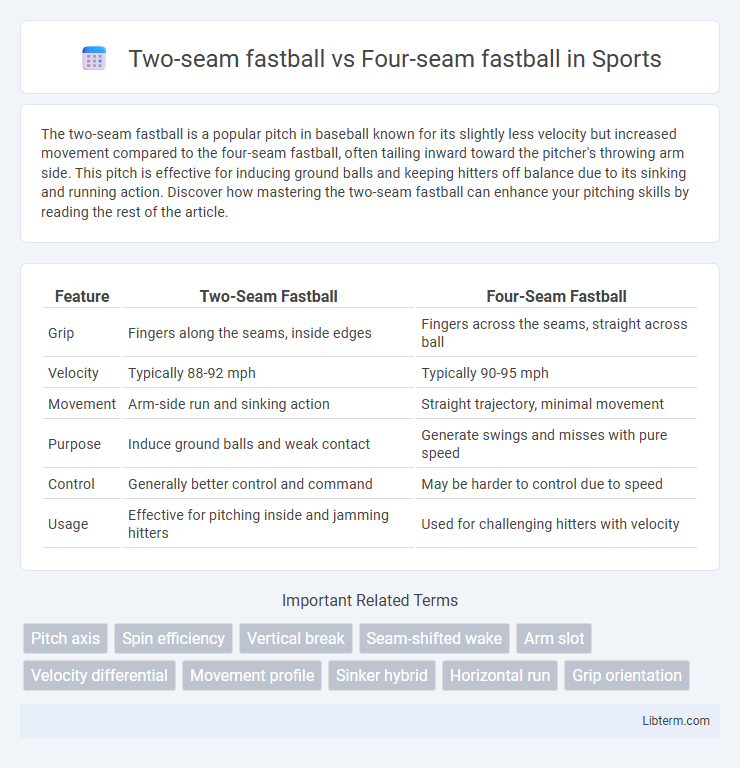The two-seam fastball is a popular pitch in baseball known for its slightly less velocity but increased movement compared to the four-seam fastball, often tailing inward toward the pitcher's throwing arm side. This pitch is effective for inducing ground balls and keeping hitters off balance due to its sinking and running action. Discover how mastering the two-seam fastball can enhance your pitching skills by reading the rest of the article.
Table of Comparison
| Feature | Two-Seam Fastball | Four-Seam Fastball |
|---|---|---|
| Grip | Fingers along the seams, inside edges | Fingers across the seams, straight across ball |
| Velocity | Typically 88-92 mph | Typically 90-95 mph |
| Movement | Arm-side run and sinking action | Straight trajectory, minimal movement |
| Purpose | Induce ground balls and weak contact | Generate swings and misses with pure speed |
| Control | Generally better control and command | May be harder to control due to speed |
| Usage | Effective for pitching inside and jamming hitters | Used for challenging hitters with velocity |
Introduction to Fastball Variations
Two-seam fastballs feature a grip along the seams that produces lateral movement, making them effective for inducing ground balls and disrupting hitters' timing. Four-seam fastballs are gripped across the seams, maximizing backspin and velocity to create a straighter, harder pitch ideal for overpowering batters. Pitchers often select between these fastball variations based on desired movement, speed, and situational strategy within a game.
What Is a Two-Seam Fastball?
A two-seam fastball is a pitch thrown with the index and middle fingers gripping along the seams of the baseball, resulting in more movement and less velocity compared to a four-seam fastball. This pitch typically exhibits horizontal tailing action toward the pitcher's throwing arm side, making it effective for inducing ground balls and weak contact. Major league pitchers often use the two-seam fastball to generate sink and run, leveraging its unique seam orientation to disrupt hitter timing.
What Is a Four-Seam Fastball?
A four-seam fastball is a baseball pitch characterized by its straight trajectory and high velocity, typically ranging from 90 to 100 mph. The grip involves placing the index and middle fingers across the seams where four seams come into contact, maximizing backspin and stability. This pitch is highly effective for strikeouts due to its speed and minimal movement compared to the two-seam fastball.
Grip Techniques: Two-Seam vs Four-Seam
The two-seam fastball grip involves placing the index and middle fingers along the narrow seams, creating more contact with the ball's surface and generating increased movement and sink. In contrast, the four-seam fastball grip positions the fingers across the wide, perpendicular seams, maximizing backspin for greater velocity and a straighter trajectory. Grip pressure and finger placement in both grips influence pitch control and ball movement, with the two-seam favoring lateral and downward action and the four-seam emphasizing speed and consistency.
Movement and Spin Differences
The two-seam fastball exhibits more horizontal and downward movement due to its grip and finger pressure, generating greater sidespin and topspin compared to the four-seam fastball. The four-seam fastball produces a straighter trajectory with higher backspin, resulting in more velocity and a perceived rising effect. Differences in spin rate and axis directly influence pitch movement, with two-seamers often sinking or tailing while four-seamers maintain a flatter plane.
Velocity Comparison
The four-seam fastball typically reaches higher velocities, averaging 92-97 mph, due to its straighter trajectory and tighter grip maximizing backspin. In contrast, the two-seam fastball usually clocks in between 88-93 mph, generating more movement with lateral and downward tailing action that sacrifices some speed. Pitchers often rely on the four-seam fastball for maximum velocity and strikeouts, while the two-seam fastball offers deceptive movement to induce ground balls.
Usage Scenarios in Gameplay
The two-seam fastball excels in inducing ground balls and defensive plays, making it ideal for pitchers facing aggressive hitters or runners on base seeking quick outs. The four-seam fastball, known for its velocity and straight trajectory, is frequently employed to overpower hitters or set up breaking pitches in high-leverage situations. Pitchers often alternate these fastballs to disrupt batter timing and optimize pitch effectiveness in diverse game scenarios.
Advantages and Drawbacks of Each Fastball
The two-seam fastball offers greater movement and sink, making it effective for inducing ground balls and limiting hard contact, but it sacrifices some velocity and can be less consistent in strike zone placement. The four-seam fastball provides higher velocity and a straighter trajectory, enabling pitchers to challenge hitters with speed and pinpoint accuracy, though it is more predictable and easier for batters to time. Choosing between these pitches depends on a pitcher's strategy: two-seamers excel in deception and pitch movement, while four-seamers dominate with power and precision.
Which Pitch Is Better for Beginners?
The two-seam fastball offers beginners better control and natural movement, making it easier to locate pitches and induce ground balls. In contrast, the four-seam fastball delivers higher velocity and straighter trajectory, which can be more challenging for novices to command consistently. For developing fundamental pitching skills, the two-seam fastball is often preferred due to its balance of speed, movement, and controllability.
Professional Pitchers’ Preferences and Examples
Professional pitchers often favor the four-seam fastball for its superior velocity and straight trajectory, making it ideal for challenging hitters. The two-seam fastball is preferred for its movement and ability to induce ground balls, with pitchers like Justin Verlander and Gerrit Cole utilizing it effectively to generate sink and lateral run. MLB pitchers tend to select the pitch based on situational needs, with the four-seam fastball used as a primary strikeout pitch and the two-seam fastball deployed to disrupt hitters' timing.
Two-seam fastball Infographic

 libterm.com
libterm.com